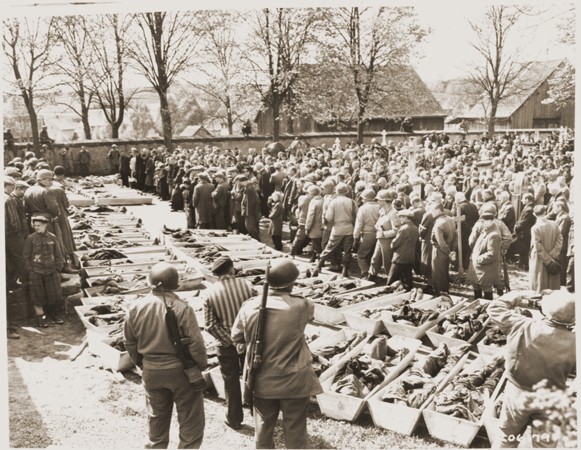
Death Marches
In January 1945, the Third Reich stood on the verge of military defeat. As Allied forces approached Nazi camps, the SS organized “death marches” (forced evacuations) of concentration camp inmates, in part to keep large numbers of concentration camp prisoners from falling into Allied hands.
-
1
The term "death march" was probably coined by concentration camp prisoners. It referred to forced marches of concentration camp prisoners over long distances under guard and in extremely harsh conditions.
-
2
During death marches, SS guards brutally mistreated the prisoners and killed many.
-
3
The largest death marches were launched from Auschwitz and Stutthof.
In the summer of 1944, a massive Soviet offensive in eastern Belarus annihilated German Army Group Center. Soviet forces then overran the first of the major Nazi concentration camps, Lublin/Majdanek. Shortly after that offensive, SS chief Heinrich Himmler ordered that prisoners in all concentration camps and subcamps be forcibly evacuated toward the interior of the Reich. Due to the rapid Soviet advance, the SS had not had time to complete the emptying of the Majdanek camp. This had allowed Soviet and western media to widely publicized SS atrocities at the camp, using both footage of the camp at liberation and interviews with some of the surviving prisoners.
The evacuations of the concentration camps had three purposes:
- SS authorities did not want prisoners to fall into enemy hands alive to tell their stories to Allied and Soviet liberators
- the SS thought they needed prisoners to maintain production of armaments wherever possible
- some SS leaders, including Himmler, believed irrationally that they could use Jewish concentration camp prisoners as hostages to bargain for a separate peace in the west that would guarantee the survival of the Nazi regime.
In the summer and early autumn months of 1944, most of the evacuations were carried out by train or, in the case of German positions cut off in the Baltic States, by ship. As winter approached, however, and the Allies reached the German borders and assumed full control of German skies, SS authorities increasingly evacuated concentration camp prisoners from both east and west on foot.
By January 1945, the Third Reich stood on the verge of military defeat. Most of German East Prussia was already under Soviet occupation. Soviet forces besieged Warsaw, Poland, and Budapest, Hungary, as they prepared to push German forces back toward the interior of the Reich. After the failure of the surprise German Ardennes offensive in December 1944, Anglo-American forces in the west were ready to invade Germany.
The SS guards had strict orders to kill prisoners who could no longer walk or travel. As evacuations depended increasingly on forced marches and travel by open rail car or small craft in the Baltic Sea in the brutal winter of 1944-1945, the number who died of exhaustion and exposure along the routes increased dramatically. This encouraged an understandable perception among the prisoners that the Germans intended them all to die on the march. The term death march was probably coined by concentration camp prisoners.
During these death marches, the SS guards brutally mistreated the prisoners. Following their explicit orders, they shot hundreds of prisoners who collapsed or could not keep pace on the march, or who could no longer disembark from the trains or ships. Thousands of prisoners died of exposure, starvation, and exhaustion. Forced marches were especially common in late 1944 and 1945, as the SS evacuated prisoners to camps deeper within Germany. Major evacuation operations moved prisoners out of Auschwitz, Stutthof, and Gross-Rosen westward to Buchenwald, Flossenbürg, Dachau, and Sachsenhausen in winter 1944-1945; from Buchenwald and Flossenbürg to Dachau and Mauthausen in spring 1945; and from Sachsenhausen and Neuengamme northwards to the Baltic Sea in the last weeks of the war.
Death Marches: Oral History Excerpts
As Allied forces advanced into the heart of Germany they liberated hundreds of thousands of concentration camp prisoners. This included thousands of prisoners whom Allied and Soviet troops liberated while they marched on the forced evacuations. On April 25, 1945, Soviet forces met US forces at Torgau, on the Elbe River in central Germany. The German armed forces surrendered unconditionally in the west on May 7 and in the east on May 9, 1945. May 8, 1945, was proclaimed Victory in Europe Day (V-E Day).
To almost the last day of the war, German authorities marched prisoners to various locations in the Reich. As late as May 1, 1945, prisoners who had been evacuated from Neuengamme to the North Sea coastline were loaded onto ships; hundreds of them died when the British bombed the ships a few days later, thinking that they carried German military personnel.
Critical Thinking Questions
- Were there witnesses to these marches? What choices might observers have faced?
- Read or listen to testimony from a death march participant. What factors may have helped them to survive that ordeal?
Further Reading
Freeman, Joseph, and Donald Schwartz. The Road to Hell: Recollections of the Nazi Death March. St. Paul, MN: Paragon House, 1998.
Marrus, Michael R., editor. The End of the Holocaust. Westport, CT: Meckler, 1989.
Strzelecki, Andrzej. The Evacuation, Dismantling and Liberation of KL Auschwitz. Oswiecim, Poland: Auschwitz-Birkenau State Museum, 2001.
Wiesel, Elie. Night. New York: Hill and Wang, 2006.